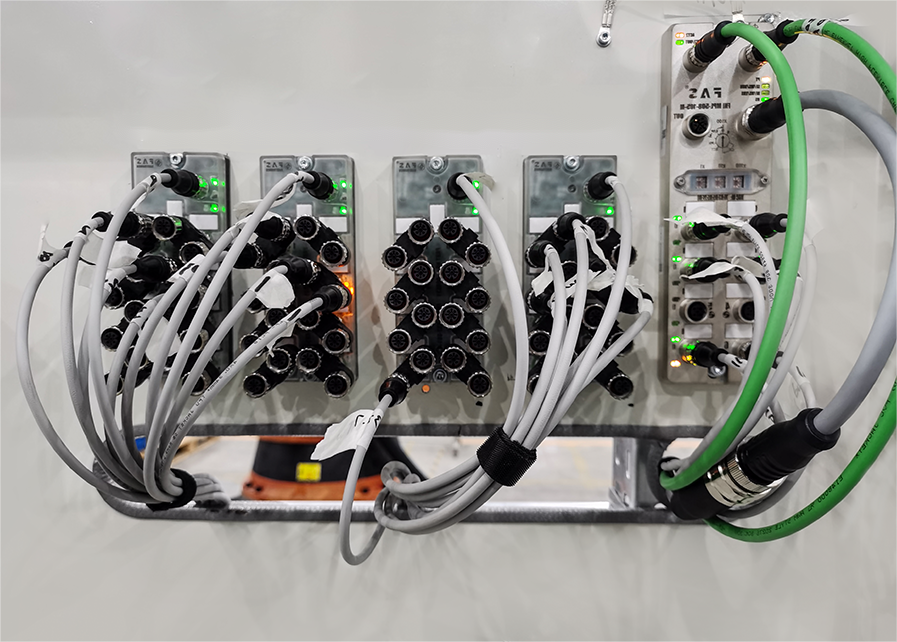IO-Link hub

In industrial automation, efficient and reliable communication is crucial for the seamless operation and control of equipment and systems. IO-Link is a popular communication protocol that provides a standardized interface between sensors, actuators and other devices, as well as controllers or monitoring systems. IO-Link Hub plays a vital role in extending and managing IO-Link networks, providing enhanced flexibility and functionality.
This article aims to provide an in-depth introduction to IO-Link Hub, covering its uses, features, benefits and application scenarios. By understanding the basics of IO-Link Hub, readers will gain insight into how these devices can help optimize industrial automation solutions. IO-Link is an industrial communication protocol that allows point-to-point communication between sensors, actuators and controllers. It operates over a standard three-wire cable and provides not only data exchange but also power to connected devices. The IO-Link protocol facilitates bidirectional communication, providing real-time data transfer, parameterization and diagnostics capabilities. It enables device interchangeability regardless of manufacturer, simplifying equipment integration and reducing downtime during replacement or maintenance.
Purpose of IO-Link Hub
Although the IO-Link Hub can be connected directly to an IO-Link master or controller, the IO-Link Hub acts as an intermediary between multiple devices and the master. The main purpose of IO-Link Hub is to expand the number of available ports to connect IO-Link Hub and simplify the cabling infrastructure. It acts as a central hub for IO-Link devices, simplifying the wiring process and reducing installation time and effort.
IO-Link Hub offers a variety of features and functions that enhance the overall performance and efficiency of your IO-Link network. Some of the key features of IO-Link Hub include:
Port expansion: IO-Link Hub provides additional ports to accommodate a larger number of IO-Link devices. Multiple devices can be connected to a single hub, reducing overall cabling complexity.
Diagnostic features: IO-Link Hubs often include diagnostic features to monitor and troubleshoot connected devices. This allows faults to be quickly identified, reducing downtime and increasing maintenance efficiency.
Flexibility: IO-Link Hub supports daisy chain or star topologies, providing flexibility in network design and layout. This allows for easy integration of devices in various configurations to suit specific system requirements.
Easy installation: IO-Link Hub simplifies the installation process by eliminating the need for separate long cables from each device to the master. Instead, the connection from the device to the hub is shorter, simplifying cable management and reducing installation time.
Remote parameterization: IO-Link Hub enables remote configuration and parameterization of connected devices. This eliminates the need for manual adjustments to each device and facilitates rapid setup and reconfiguration of automated systems.
Device interchangeability: IO-Link Hub supports device interchangeability, devices from different brand manufacturers can be connected to the same IO-Link master, providing flexibility and freedom of choice during system expansion or replacement.
Advantages of using IO-Link Hub Using IO-Link Hub in industrial automation systems offers several advantages that help increase productivity, increase reliability and simplify maintenance. Here are some of the main advantages:
Reduced wiring complexity: IO-Link Hub minimizes the length and complexity of wiring by acting as a central connection point for multiple devices. This simplifies cable management and reduces installation effort and cost.
Enhanced scalability: IO-Link Hub makes it easy to expand the IO-Link network by providing additional ports for connecting devices. This scalability allows for future deployments without major rewiring.
Save time and costs: The simplified wiring process and fast device integration provided by IO-Link Hub can save a lot of time and costs. In addition, the remote control function reduces manual configuration work and further optimizes the maintenance process.
Improved diagnostics: IO-Link Hub facilitates advanced diagnostics of connected devices, enabling real-time monitoring and rapid fault detection. Speeds troubleshooting, reduces downtime, and increases overall system availability.
Interoperability and device interchangeability: IO-Link Hub supports device interchangeability between different manufacturers, promoting greater flexibility and freedom of choice. It promotes an open ecosystem and avoids vendor lock-in.
Future-proof: By implementing IO-Link Hub, companies can prepare for future advances and changes in automation technology.
Application Scenarios IO-Link Hub is suitable for various industrial automation scenarios in different industries. Some common application scenarios include:
Machine Automation: IO-Link Hub is used for machine automation where multiple sensors, actuators and other devices need to be integrated into the control system. It simplifies the cabling process, reduces installation time and simplifies equipment management.
Material handling systems: IO-Link Hub plays a vital role in material handling systems. They provide centralized connectivity solutions for numerous sensors and actuators, ensuring seamless operation and efficient data exchange.
Packaging machinery: In packaging machinery, IO-Link Hub can integrate various devices such as photoelectric sensors, proximity sensors, valves and clamps. They simplify cabling infrastructure and facilitate rapid equipment replacement and maintenance.
Process Automation: IO-Link Hub is also used in process automation systems to connect instruments, valves and other devices to control systems. They enable flexible and reliable communication, increase process efficiency and reduce downtime.
Industrial Internet of Things (IIoT): IO-Link Hub is an important component of IIoT implementation, allowing real-time data collection from sensors and actuators. This data can be used for analysis, predictive maintenance and optimization of industrial processes.
in conclusion:
IO-Link Hub provides a central connectivity solution for IO-Link devices, expanding network capacity while simplifying installation, reducing cabling complexity and improving diagnostic capabilities. With features such as port expansion, diagnostic functions, flexibility and remote parameterization, IO-Link Hub enhances the performance, reliability and scalability of industrial automation systems. The benefits of using IO-Link Hub include reduced costs, enhanced interoperability and simplified maintenance, making it a valuable component in a variety of application scenarios across different industries. By leveraging IO-Link Hub, organizations can optimize their automation networks, increase productivity, and prepare for future advances in industrial communications technology.

